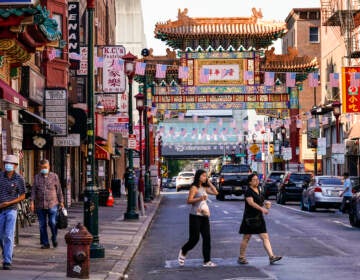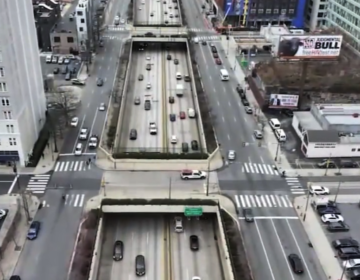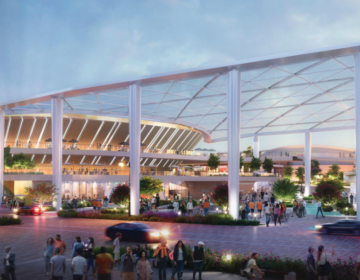New details emerge about Sixers’ proposal for new arena
The team behind the billion-dollar development led a media tour of the potential footprint of the arena on Friday afternoon.
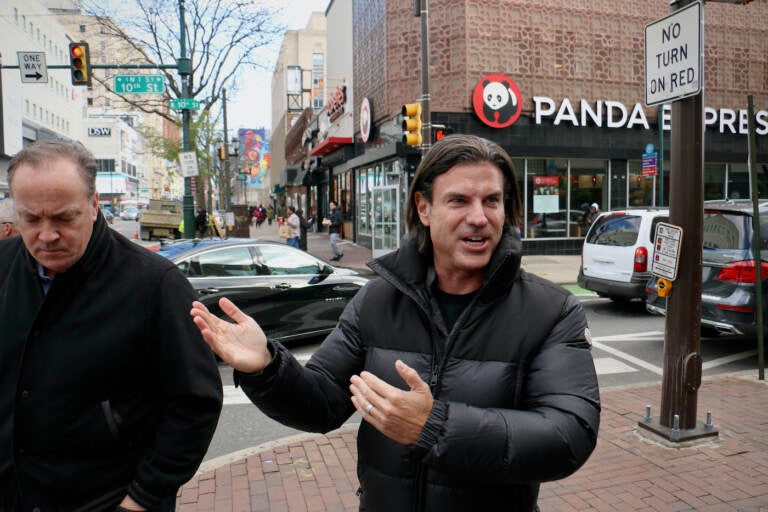
David Adelman, part owner of the Philadelphia 76ers, stands at the corner of 10th and Market streets, across the street from where the team hopes to build a new arena (Emma Lee/WHYY)
The team behind 76 Place — the basketball arena the Sixers want to bring to Center City Philadelphia — hopes to have the zoning approval it needs to start construction by June 2023, and a community benefits agreement in place before that.
The new details emerged during a Friday afternoon media tour of the proposed footprint of the estimated $1.3 billion development, which would replace a blocklong section of the Fashion District mall on Market Street between 10th and 11th Streets.
Both goals are considered critical to the new arena becoming a reality in 2031, when the franchise’s lease is up at the Wells Fargo Center in South Philadelphia.
“We’re already underway,” said billionaire developer David Adelman, the chief executive officer of Campus Apartments who recently became a Sixers minority owner.
Once finalized, the community benefits agreement could be valued at $50 million, said Adelman, and include money for initiatives aimed at improving public safety, supporting small businesses, and affordable housing. It would remain in place for at least 30 years and be legally binding.
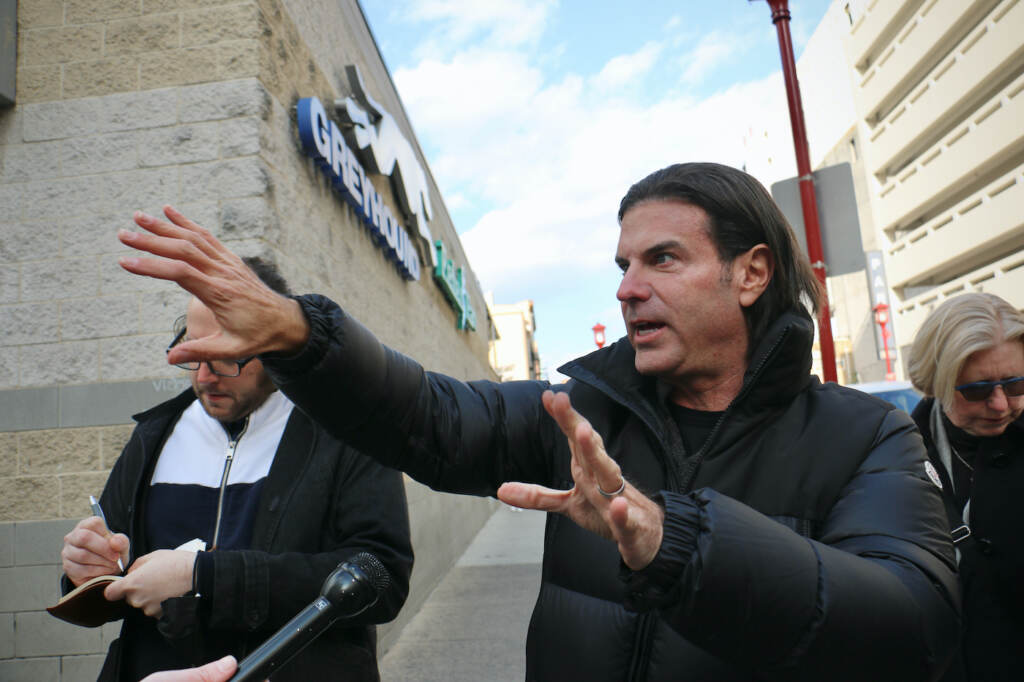
Since announcing the project in July, Adelman said he’s participated in more than 80 meetings with more than a dozen community groups representing Chinatown. He said the majority of people he’s presented the project to are “neutral to positive” about the development, making him hopeful an agreement can get done sooner rather than later.
“I think people are really receptive to what we’re looking to do. And the main reason is if we don’t do this and the mall goes bankrupt, someone knocks it down, you could build three Liberty Place towers on those three blocks by right…and the community would get nothing,” said Adelman.
At this stage, it’s unclear when the zoning process, which requires legislation to be passed in City Council, might get underway. The team’s proposal needs a variance for construction to start because an arena is considered a special use under the city’s zoning code.
City Councilmember Mark Squilla, whose district contains the proposed site, said it’s too early for a timeline for introducing legislation for the project.
“There is a lot more community engagement that is needed before we would get to that point,” said Squilla, who has signaled support for the project.
During Friday’s tour, Adelman was joined by Sixers CEO Tad Brown. With a small group of reporters in tow, the pair focused on their desire to inject new life into a section of Market East that has struggled to soar despite multi-million dollar investments over the years, including the Fashion District.
Between games and other events, the two-level arena would be active upwards of 150 days each year, mostly at night. Brown and Adelman envision fans enjoying a couple of hours of basketball, then heading out to eat and drink in Center City or Chinatown.
The design of the proposed arena, which may hold more than 18,000 people, will also include some kind of connection to the remaining parts of the mall. And Filbert Street, between 10th and 11th, would be closed to car traffic to allow for a pedestrian concourse that would remain open on non-event days.
“It’s gonna be a living, breathing part of this community that’s hopefully going to be an epicenter of growth,” said Brown.
Not everyone is excited about that prospect.
Friday’s tour came as opposition to the hypothetical arena begins to solidify.
Longtime community activist Deborah Wei said there are now 20 organizations part of the Save Chinatown Coalition, and predicts “a lot more” will sign on in the coming weeks.
Most of the coalition’s current members are based in Chinatown, including the newly-created Concerned Citizens of Chinatown Association. But the alliance also includes groups like Center City Organized for Responsible Development, a registered community organization, and Arch Street United Methodist Church.
The group’s overarching — and most grave — concern is that a new arena will dismantle and ultimately destroy the Chinatown that people know today.
“It’s sort of like how biodiversity is really important to any environment. [The arena] is erasing the biodiversity of what makes a city a city. And you’re not going to ever get it back. If you lose Chinatown, it’s gone,” said Wei, who helped co-found Asian Americans United.
Adelman and Brown are pitching the project as a transit-oriented development that will see the vast majority of fans travel to games by foot or public transportation.
Running beneath or near the proposed arena site, are 13 Regional Rail lines operating out of Jefferson Station. There are also stations nearby for the Broad-Ridge Spur, the Broad Street Line, PATCO, and the Market-Frankford El, the “workhorse” line that SEPTA expects to transport most fans to and from games if the project goes forward.
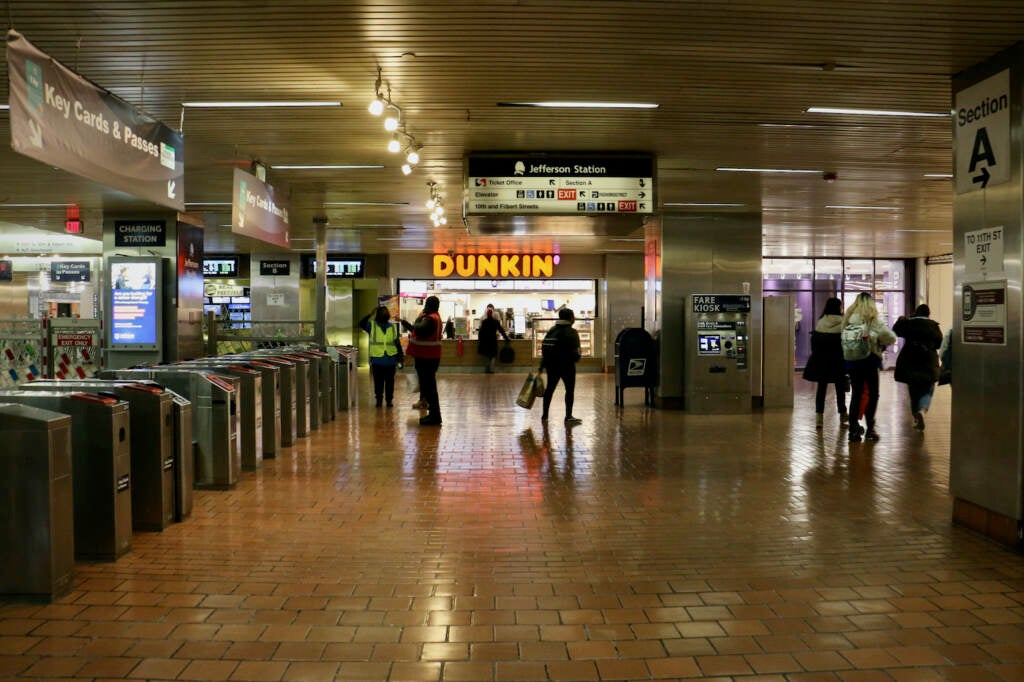
“For those who choose to drive, the site is within a half-mile radius of 29 parking garages operating with significant spare capacity,” according to the 76 Place website.
But critics in Wei’s camp argue games — and other events at the proposed arena — will still bring considerable traffic to a corner of the city that routinely struggles with congestion, deterring diners and other visitors from coming to Chinatown as a result.
Sam Sam, who owns Little Saigon Cafe on North 10th Street, said the cost of parking and concessions at the arena, will also dissuade people from spending more in Chinatown before or after events.
“They can say what they want,” said Sam. “It will kill all the business.”
Underlying all of it, are concerns that the arena will contribute to gentrification and displacement, rooted in property taxes becoming prohibitive for current residents and business owners over time.
The Chinatown community is not universally against the project. At least, not publicly, said Jonathan Waldman, an attorney who has lived in Chinatown for nearly a decade and helped launch the Concerned Citizens of Chinatown Association.
Waldman, whose Chinese-American wife has deep roots in the neighborhood, said a number of the business owners and residents he’s talked to about the project are taking a “wait and see” approach, saying they don’t have enough information yet to take a definitive stance.
“There’s a lot of unanswered questions,” said Waldman.

Get daily updates from WHYY News!
WHYY is your source for fact-based, in-depth journalism and information. As a nonprofit organization, we rely on financial support from readers like you. Please give today.





